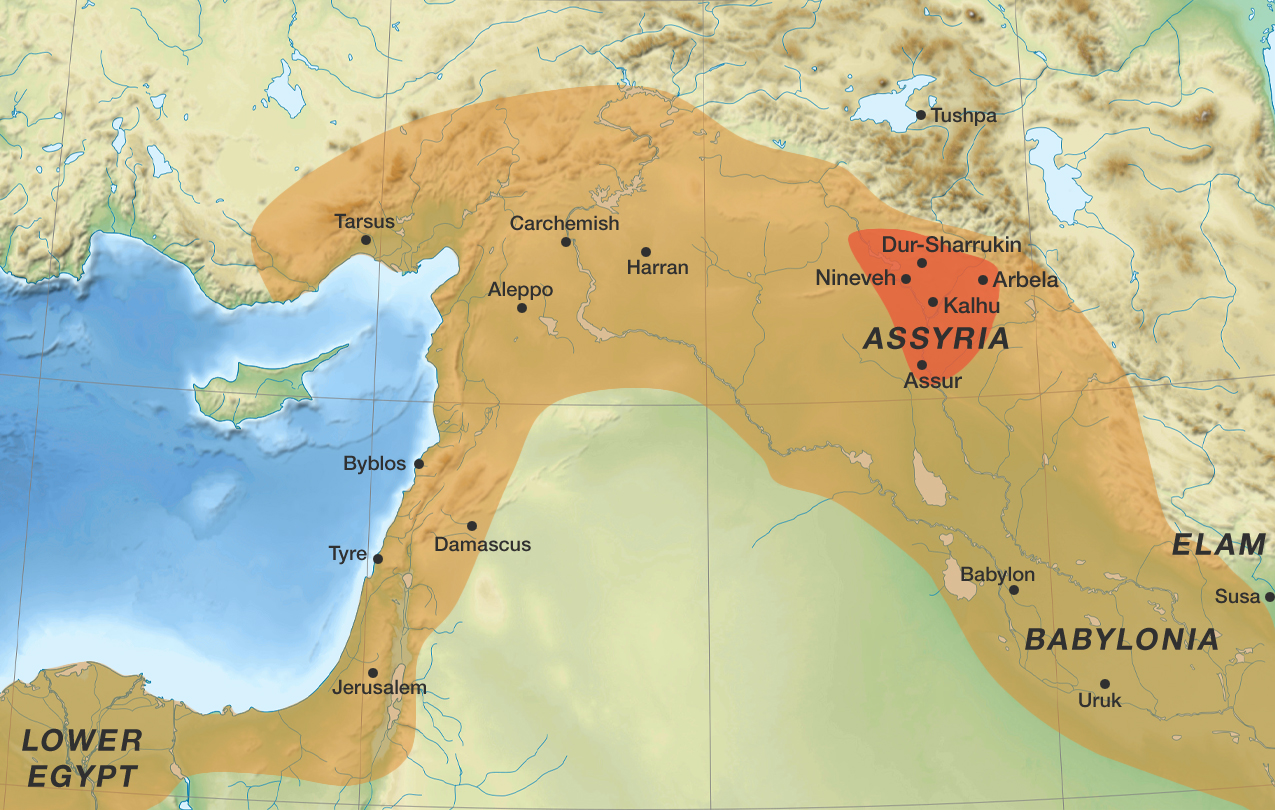What does the Bible say about…
Assyria
also known as: Asshur
This is the name of a powerful ancient land whose capital city was Assur (Asshur), located on the Tigris River. This major ancient Mesopotamian civilization existed from the 21st century BC and eventually expanded into a vast empire from the 14th century BC to the 7th century BC, achieving its greatest extent under the reign of King Assurbanipal (668-627 BC). Its heartland cities included Nineveh, Assur, Kalhu, Arbela, and Dur-Sharrukin.
See: Assur / Asshur—the son of Shem, the city and the land
The people of this land are called both Asshur and Assyrian (usually the later to avoid confusion).
The Assyrians were Semites (Genesis 10:22), but over time non-Semite tribes mingled with the inhabitants.
Assyria was a mountainous region lying to the north of ancient Babylonia, extending along the Tigris as far as to the high mountain range of Armenia, the Gordiaean or Carduchian mountains.
They were a military people, the “Romans of the East.”
Little is positively known of the early history of the kingdom of Assyria. In 1120 BC Tiglath-Pileser I, the greatest of the Assyrian kings, “crossed the Euphrates, defeated the kings of the Hittites, captured the city of Carchemish, and advanced as far as the shores of the Mediterranean.”
After this, the Assyrians gradually extended their power, subjugating the states of Northern Syria.
In the reign of Ahab, king of Israel, Shalmaneser II marched an army against the Syrian states, whose allied army he encountered and vanquished at Karkar. This led to King Ahab’s casting off the yoke of Damascus and allying himself with Judah.
Some years after this the Assyrian king marched an army against Hazael, king of Damascus. He besieged and took that city. He also brought under tribute Jehu, and the cities of Tyre and Sidon.
About a hundred years after this (745 BC) the crown was seized by a military adventurer called Pul, who assumed the name of Tiglath-Pileser III. He directed his armies into Syria, which had by this time regained its independence, and took (740 BC) Arpad, near Aleppo, after a siege of three years, and reduced Hamath. Azariah (Uzziah) was an ally of the king of Hamath, and thus was compelled by Tiglath-Pileser to do him homage and pay a yearly tribute.
In 738 BC, in the reign of Menahem, king of Israel, Pul invaded Israel, and imposed on it a heavy tribute (2 Kings 15:19). Ahaz, the king of Judah, when engaged in a war against Israel and Syria, appealed for help to this Assyrian king by means of a present of gold and silver (2 Kings 16:8); who accordingly “marched against Damascus, defeated and put Rezin to death, and besieged the city itself.” Leaving a portion of his army to continue the siege, “he advanced through the province east of Jordan, spreading fire and sword,” and became master of Philistia, and took Samaria and Damascus.
He died in 727 BC, and was succeeded by Shalmanezer IV, who ruled till 722 BC. He also invaded Syria (2 Kings 17:5), but was deposed in favor of Sargon the Tartan, or commander-in-chief of the army, who took Samaria after a 3 year siege, and so put an end to the kingdom of Israel, carrying the people away into captivity, 722 BC (2 Kings 17:1-6, 24; 18:7, 9).
He also overran the land of Judah, and took the city of Jerusalem (Isaiah 10:6, 12, 22, 24, 34).
Mention is next made of Sennacherib (705 BC), the son and successor of Sargon (2 Kings 18:13; 19:37; Isaiah 7:17-18); and then of Esar-haddon, his son and successor, who took Manasseh, king of Judah, captive, and kept him for some time a prisoner at Babylon, which he alone of all the Assyrian kings made the seat of his government (2 Kings 19:37; Isaiah 37:38).
Assurbanipal, the son of Esarhaddon, became king, and in Ezra 4:10 is referred to as Asnapper. From an early period Assyria had entered on a conquering career, and having absorbed Babylon, the kingdoms of Hamath, Damascus, and Samaria, it conquered Phoenicia, and made Judea feudatory, and subjected Philistia and Idumea.
At length, however, its power declined. In 727 BC the Babylonians threw off the rule of the Assyrians, under the leadership of the powerful Chaldean prince Merodach-baladan (2 Kings 20:12), who, after twelve years, was subdued by Sargon, who now reunited the kingdom, and ruled over a vast empire.
But on his death the smouldering flames of rebellion again burst forth, and the Babylonians and Medes successfully asserted their independence (625 BC), and Assyria was destroyed.
Prophecy fulfilled
This happened just as was prophecied by Isaiah (10:5-19), Nahum (Nahum 3:19), and Zephaniah (Zephaniah 2:13), and the many separate kingdoms of which it was composed ceased to recognize the “great king” (2 Kings 18:19; Isaiah 36:4).
Ezekiel (Ezekiel 31) attests (about 586 BC) how completely Assyria was overthrown. It ceases to be a nation.
Kings of Assyria
- Sargon I (about 1920–1881 BC)
- Tiglath-Pileser I
- Shalmaneser I (about 1273–1244 BC)
- Shalmaneser II (1030–1019 BC)
- Tiglath-Pileser II (966–935 BC)
- Ashur-dan II (934–912 BC), son of Tiglath-Pileser II
- Shalmaneser III (859–824 BC)
- Shalmaneser IV (783–773 BC)
- Tiglath-Pileser III (aka Pul) (745–727 BC)
- Shalmaneser V (727–722 BC), conquered Samaria and the Kingdom of Israel and was later deposed and killed by Sargon II in a coup
- Sargon II (722–705 BC)
- Sennacherib (705–681 BC)
- Esarhaddon (681–669 BC)
- Ashurbanipal (aka Assur-bani-pal, Asnapper, Osnapper) (669–631 BC) —son of Esarhaddon
- Sîn-šar-iškun (627–612 BC), son of Ashurbanipal, killed by the Babylonians and Medes at the fall of Nineveh
- and many others
Archaeology
A large trade in high status ivory was carried on by the Assyrians (Ezek. 27:6; Rev. 18:12).
Many specimens of ancient Assyrian ivory-work have been preserved.
